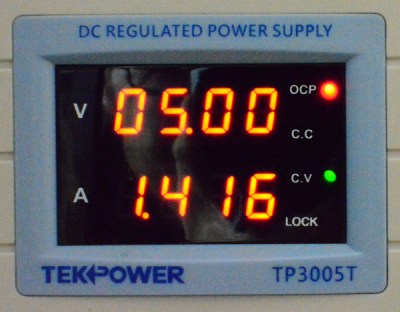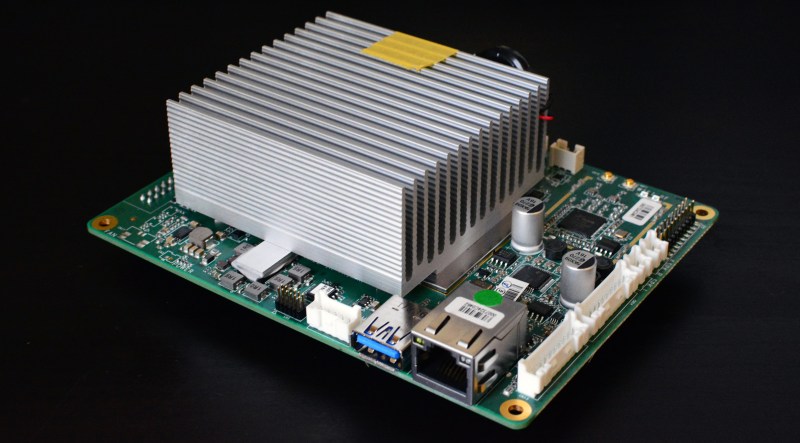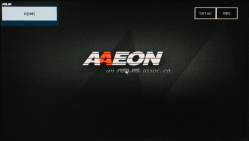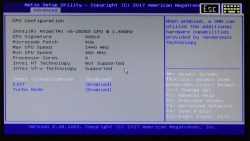Several months ago, a strange Kickstarter project from ‘Team IoT’ appeared that seemed too good to be true. The Atomic Pi was billed as a high-power alternative to the Raspberry Pi, and the specs are amazing. For thirty five American buckaroos, you get a single board computer with an Intel processor. You get 16 Gigs of eMMC Flash, more than enough for a basic Linux system and even a cut-down version of Windows 10. You have WiFi, you have Bluetooth, you have a real time clock, something so many of the other single board computers forget. The best part? It’s only thirty five dollars.
Naturally, people lost their minds. There are many challengers to the Raspberry Pi, but nothing so far can beat the Pi on both price and performance. Could the Atomic Pi be the single board computer that finally brings the folks from Cambridge to their knees? Is this the computer that will revolutionize STEM education, get on a postage stamp, and sell tens of millions of units?
No. The answer is no. While I’m not allowed to call the Atomic Pi “literal garbage” because our editors insist on the technicality that it’s “surplus” because they were purchased before they hit the trash cans, there will be no community built around this thirty five dollar single board computer. This is a piece of electronic flotsam that will go down in history right next to the Ouya console. There will be no new Atomic Pis made, and I highly doubt there will ever be any software updates. Come throw your money away on silicon, fiberglass and metal detritus! Or maybe you have a use for this thing. Meet the Atomic Pi!
x86? In My Single Board Computer Ecosystem? It’s More Likely Than You Think.
At first glance, the Atomic Pi doesn’t look like your usual single board computer. There’s no power jack or USB port, something that we’ve come to expect on all our little electronic baubles. It seems the Atomic Pi is simply a module meant for a larger product. With this many JST connectors, you would just assume this is a module custom-built for a larger product. Probably not something relating to automotive tech, but at the very least some sort of IoT home goods product. Maybe even a robotic juicer.
Speculation is one thing, and proof is another. Here’s the FCC documentation for the Atomic Pi. This thing was originally designed for the Kuri robot, a ‘home robot’ that was launched at CES in January, 2017. The robot originally cost $700, and was described as, ‘an Amazon Echo with wheels and eyes’.
Amazon will be releasing their own ‘Echo duct taped to a Roomba’ in the next year or so, and the Kuri robot was before its time. Mayfield Robotics, the makers of the Kuri, paused operations. But they still had some hardware sitting around, notably some fancy single board computers loaded up with an x86 chip. These modules went on the auction block and Team IoT snapped them up and put together a Kickstarter. This is the Atomic Pi. It is industrial surplus repackaged as a novelty device marketed towards people who ‘do things’ with single board computers. What kind of things? I have no idea. Emulators? Home automation? A magic mirror?
Only about 28,000 Atomic Pis will ever be produced. They’re already made, and right now the ones that haven’t been shipped are sitting in a warehouse, ready to be flashed with the latest OS. Atomic Pi has misrepresented themselves by saying they ‘built’ several thousand units already. This is incorrect, the only engineering that has gone into the Atomic Pi is the power adapter and breakout board.
The people behind the Atomic Pi are working on an Atomic Pi 2, or something of that nature, and while there are very few details, we do know this will cost significantly more than $35. In the meantime, we have something that is a surplused bit of an unsuccessful product. Again, less than thirty thousand Atomic Pis will ever be produced, a fraction of the number of Ouya consoles ever built. The Raspberry Pi sold 100,000 on the first day, and I haven’t even seen an old Pi with a 26-pin header and a real RCA jack in ages.
I could very easily say this is the Silicon Valley ideal of repackaging literal garbage and selling it as a groundbreaking disruption, but I don’t write for Slate or The Atlantic. No, the Atomic Pi is what you get when you try to fill an existential void by buying stuff. The Atomic Pi fills a market need for guys who think the ability to install Kali Linux constitutes a personality.
The Review
The Atomic Pi features an Intel Atom x5-Z8350, a quad-core SoC designed for Windows tablets. This is a three-year-old chip clocked at 1.44 GHz (base, up to 1.92 GHz) with 2 GB of RAM. There’s a DirectX 11.2-capable GPU, and overall you’re looking at a system that would have been more than acceptable for desktop use in 2010, sufficient for Outlook and Word in 2015, and something that’ll run emulators in 2020. In other words, if you put this into the context of a desktop computer, you’ll be getting something that plays Fallout 3. Maybe Fortnite. The GPU (Cherry Trail) is supported by Linux, and has support for OpenGL and video decoding. We’re not dealing with a crappy Mali GPU here; this one actually works.
The Atomic Pi isn’t being sold as a tiny brick of a desktop computer with a huge heatsink. This is a single board computer, and any review must place it in the context of being a single board computer. This means it must have some GPIO pins, or some way to blink an LED from the command line. Here, the Atomic Pi is sufficient for limited applications: you get six GPIOs and two UARTs. There are a few additional GPIOs and other ports sprinkled around the board, including a few USB ports on JST connectors. In terms of support for add-ons, external coprocessors, and other connectivity, the Atomic Pi is sufficient. There will never be an entire ecosystem built around add-on boards for the Atomic Pi, but that’s what happens when you only make a few thousand of something.

In terms of software support, the Atomic Pi ships with Ubuntu 18.04.1 LTS; this is simply what you do when you ship a plain vanilla single board computer with Linux — just grab the latest Ubuntu LTS and call it a day. WiFi and Bluetooth work in Linux, although you will need antennas, and neither the WiFi or Bluetooth RF section of the board have metal RF shields installed.
The real question: does the Atomic Pi do Windows? Yes, however Windows 10 is tight on 16 GB of eMMC. To do anything useful, you’ll need to install from an SD card, and with that comes the problems of running an OS from an SD card we see in all single board computers.
Finally, the big question. The question everyone wants answered. Does the Atomic Pi do emulation? It doesn’t matter: google analytics data tells me that you’re probably reading this on a desktop or a laptop, not a mobile device. You therefore have access to a much more powerful computer that is capable of emulating N64 and Playstation games. Don’t bother with emulation on the Atomic Pi. According to the community, emulation is a waste on both the Atomic Pi and the Raspberry Pi.
Atomic Pi: Should You Bother?
No, you shouldn’t bother. You just wasted precious moments of your life reading this review. Sorry about that.
Any review, or any consideration at all of the Atomic Pi, must take into account that it will ultimately be a passing mention in a footnote of the history of single board computers. There is no future when there are no more than thirty thousand of these boards to go around. This isn’t necessarily a bad thing, as many impressive builds have started off by finding some discarded equipment on the side of the curb, left out for the trash. But a single board computer is ultimately defined by its ecosystem. With a baked-in production limit, there can be no community. Without a community, there is no future.
If you want a toy, sure, pick up an Atomic Pi. Here’s the link. If it’s out of stock, there’s probably going to be more. But the selling points the Atomic Pi offers — an x86 machine for cheap, with HDMI, that can run Windows — is satisfied by better machines. Take a look at the AcePC T11. This is an x86 box that uses the same chipset as the Atomic Pi, has double the amount of RAM, more eMMC, and support for a SATA drive. It only costs $130, and that gets you a power supply, more than one USB port, WiFi and Bluetooth antennas, and an enclosure. You also get a power supply. Did I mention the AcePC 11 includes a power supply?
Alternatively, if you want the same Intel chip in a pocketable form factor, the AcePC T5 plugs right into an HDMI port. It uses the same Cherry Trail CPU as the Atomic Pi and comes with WiFi and Bluetooth antennas. The AcePC T5 also comes with a power supply and costs only $100.
The price reference for the single board computer market has been set by the Raspberry Pi, and that means thirty five dollars. Right now, I can buy a Pi 3 Model B+ for thirty seven dollars and seventy eight cents, with free one-day delivery from Amazon. Any competitor to the Raspberry Pi must beat it on either price or performance. The OrangePis and their ilk compete on price. The Atomic Pi certainly beats the Pi on performance and meets it on price. However, this is a false economy, as the Atomic Pi is one-off industrial surplus. If that’s your thing, and you need a cheap x86 system, go for it. But there are better options, and you will only save money by confabulating your own power supply if you value your time at zero.























atmoic pi doesnt join into the sbc sphere from the start, meanwhile, it cant beat a laptop running windows.
its industrial surplus. thats WHY.
no one is dump here:)
This article is more broken and deceptive than the product it attempts to deface. It is a wonderful example of the decline in journalism were authors stray from facts and bloat on opinion.
I know this article is a year old, but I just want to say that this article, like the author said, was A WASTE OF TIME. As others have said, just because it’s repurposed, doesn’t mean it belongs in the landfill! Fine, the Kickstarter page wasn’t 100% true, and rigging up power is weird. I know, I own an Atomic Pi. Also please note: the board was manufactured by AAEON, which is an award winning Taiwanese company, and part of ASUS! A lot of SBC mfg’s are straight from China!
Think about it! For $35 you actually get a functional x86 based computer!!! With an Intel chip, no less! When someone can find something else like this, I’ll have to slap myself to make sure I’m not dreaming!
Mr. Benchoff uses unnecessarily degrading terms in this “review”, and doesn’t seem to understand WHY SBCs are loved. Like some of the other commenters, low budget taught me to hack computers together for free. Until recently I even had one with a floppy drive and WinXP. If you want to slam an SBC for low community support, there’s also the Orange Pi, the ASUS Tinker Board, the NanoPis, you get the point. Just about all the non RPi SBCs out there have small communities! And seriously, x86 has SO many OS options compared to ARM boards like the RPi. And REALLY? Recommending a $130 conventional desktop PC over this thing?? Not even fair! If I had that kind of budget, I’d get myself a full blown desktop! But if someone’s reading this, they’re probably not looking for a desktop PC! They’re probably looking for an SBC to tinker with!
Contrary to that this article says, more than 28000 units were manufactured. 28000 units (which is a VERY limited production run, in an industry like electronics where a company will usually manufacture over a MILLION units at a minimum), with INTEL CPUs no less, would have sold out in a couple WEEKS. But they are STILL for sale on Amazon and other websites. And it’s not like these are used units that their owners re-sold. Nobody would get rid of something like this. And this is the IDEAL computer for any computer programmer who wants to move into the embedded computer realm. Most programmers on modern PCs, are used to writing C or C++ for Windows, which requires an x86 or x64 CPU to run. Before the Atomic Pi, if you wanted to experiment with programming a simple embedded computer you only had the Raspberry Pi available, which has an Arm processor, and thus could NOT run Windows. If you were a Windows programmer, and wanted to program for the Raspberry Pi, you needed to throw out ALMOST EVERYTHING you ever knew about programming, and start learning from scratch. This was WAY too big of a hurdle for most programmers to overcome, if they wanted to transition from Windows desktop programming to embedded computer programming. Fortunately the Atomic Pi solved that problem. Just uninstall the copy of Linux that comes with it, and install a copy of Windows 2000 from WinWorldPC, and you will be set to run Windows in an embedded system. To program it, just write the program in your favorite programming language on your desktop or laptop, and then copy it via a USB drive over to the Atomic Pi, and then use your keyboard and mouse on the Atomic Pi to doubleclick the EXE file of the program in Windows Explorer on your Atomic Pi to run the program on the Atomic Pi. I’m absolutely certain that given that usefulness to the programming community, the Atomic Pi sold WELL OVER 28000 units by now (probably 10 times that many, at least). And there’s STILL many units available, from Amazon.com and other websites.
And both of the websites I’ve checked, neither of them say ANYTHING like “out of production, limited quantity remaining”.
And to the article author saying there’s no accessories or ecosystem for it, there’s actually TWO breakout boards for it, a large one and a small one.
I came up to this article and completely agree with author, in 2022 it’s clear where it end up.
I always got feeling that Atomic Pi was not designed as SBC but something else. It’s huge and all connectors looks more like designed for vacuum than any kind of computer :) I didn’t knew that it was part of failed kuri robot.
Today still You can get atomic pi for about $35 (ameridroid has it discounted from $139.95 USD, haha) . Community already died, but it’s not big problem for x86 computer. Since Rpi4 it blasts APi in all aspects, it can even run win today if that is your wish ;) For any project You will use something small, there are many x86 boards today and You can get something like dell wyse 3040 which is something APi should be right from start.
The author was just right.
I am here to announce that I have found a purpose for my Atomic Pi. I have one of those Turing Pi clusters running Kubernetes and I want to se how it runs on the Akash Network — a crypto project that allows you to sell cloud services to strangers. How much money can my cluster earn, I wondered? Well the Akash Network doesn’t give a damn what hardware your cluster uses except THE MASTER NODE HAS TO BE X86. For telling a bunch of Raspberry Pi Compute Module 4s what to do, my $43.95 Atomic Pi is PERFECT. Mission accomplished.
Came across this because I came upon a bunch of atom tablets with the same CPU and thought about turning them into SBCs.
Lo and behold, all these years after this article, Raspberry Pi’s have yet again become unobtanium (“chip shortage,” or whatever the excuse is, this time), and yet here these goofy surplus boards look to be still available from regular sources at a decent price…
There’s a lot to be said about surplus; I’m glad at least a few folk weren’t so short-sighted as to allow these to wind up in the trash!
Top it off, Someone else wasn’t so shortsighted as to allow a slew of Atom tablets with worn batteries to wind up in the trash, as well. So now, finding this, puting effort into those tablets won’t be nearly so niche; those efforts could just-as-well apply to an Atomic Pi; and if the tablet “SBCs” kaput, and those tablets can’t be found, it would seem there’s a somewhat-standard replacement part… which someone called “garbage.”
Isn’t this *Hack* a Day? What better than to hack “garbage” into something useful?
Oh right… This place ain’t the same without yah, Benchoff!
The negativity of this review is truly astounding. Brian must have been having a terrible week to want to write something so cruel about a bunch of people doing their best to reduce waste and re-allocate and distribute cool, capable compute hardware.